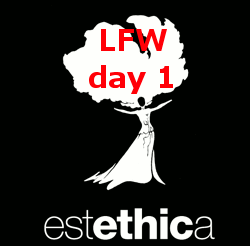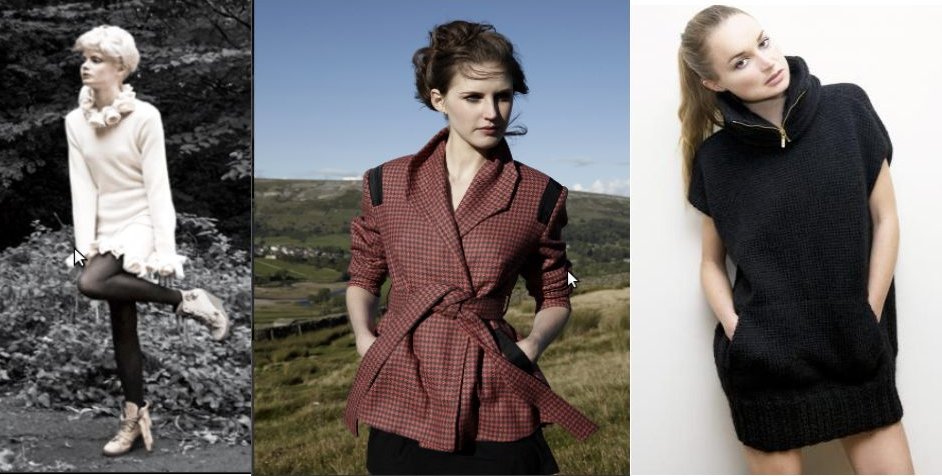 Previously: TheyKey.to, Berlin: Summary – Where is it heading for? A few insights
Previously: TheyKey.to, Berlin: Summary – Where is it heading for? A few insights
Tomorrow: London Fashion Week February 2011: D2 – EstEthica: How ethical is ethical?
One of the first answer of the sustainable food movement was ‘buy and eat locally’. In a similar attempt, one of the key phrases heard repeatedly in the discussions surrounding sustainability and ethics in fashion is ‘buy made in your country: Made in Britain, Made in France, Made in Spain, Made in Germany. It is a slogan that certainly feels omnipresent throughout London Fashion Week (where overall it seems that the number of non-UK based designers is decreasing with every season), and is equally tangible at EstEthica.
When talking about ‘made in Britain’, one of the keywords that invariably crops up rather sooner than later is the use – or rather: the lack thereof – wool in the fashion industry, and the old, yet persistent cliché of wool garments being itchy, uncomfortable to wear, and in any case anything but fashionable.
The British wool mark and the Campaign for Wool are the UK’s attempts to make the fibre more attractive to a general public, beyond the carpet industry (which uses approximately 70% of the wool harvested in Britain). While the mark and the campaign are recent efforts to raise awareness of (locally produced) wool as a fibre, and the range and breadth of its potential uses, the principle issues date back much further. In fact they started with the industrial revolution and with (locally produced) wool loosing ground, notably for clothing, to imported cotton by the day. In the 1950s a rather bureaucratic agency, the British Wool Marketing Board, was brought to life, whose task was then defined – at it remains unchanged since – as:
Under the Wool Marketing Act of 1950, the BWMB is required to register all producers with four or more sheep (with the exception of Shetland, which has its own arrangement). There are currently 59,078 registered producers. (Source)
In short: the sheep breeders are required to sell their wool to the BWMB, which in turn essentially acts as a middleman – although, truth be told, at the end of the day much of the wool does get sold through auctions, rather than actual sales channels.
Breeders who would like to make private use of their wool for one purpose or another have to declare this in writing – a well meant, but not entirely successful means intended to prevent the farmers, who breed sheep normally for meat production, from burning the fleeces after shearing, for the effort to deal with them is more expensive than mere disposal. This said, the BWMB’s reputation is increasingly coming under pressure. Specifically the apparent lack of awareness with respect to fibre quality – the key to British wool being used in textile crafts and also apparel design – raises more than one eye brow among the few sheep farmers that care – a tiny minority – and the those craftsmen and designers that decide to buy British wool through the BWMB.
What is often forgotten among all this though, is that a lot of knowledge about and attractiveness of a fibre from a consumer’s point of view, comes from its use in the textile/apparel industry, and eye catching, ‘like to wear’ designs, that bear the potential of becoming classics.
This was – and continues to be – the key aspect of 2 of the most renowned wool fabrics producers in the UK. Both, accidentally?, located in Scotland:
- Harris Tweeds is probably the longest running company that capitalises on the British wool tradition, as well as the highly developed textile skill of geographically marginalised communities. In fact, the term ‘Harris Tweed’ has a very clear definition:
Harris Tweed means a tweed which has been hand woven by the islanders at their homes in the Outer Hebrides, finished in the islands of Harris, Lewis, North Uist, Benbecula, South Uist and Barra and their several purtenances (The Outer Hebrides) and made from pure virgin wool dyed and spun in the Outer Hebrides.(Source) - Another similar and already company came from an effort to revive the weaving community and skills native to the Isle of Mull. Ardalanish is an organic farm, a weaving mill, and a clothing label. They bread their native sheep in an organic manner, and the mill produces fabrics from the fleeces of those sheep. The colours of their fabrics are the outcome of consciously using the natural and undyed colour gamut offered by sheep wool from different native breeds. They create whole sale fabrics, bespoke fabrics, and also their own clothing collections which are designed in collaboration with renown designers.
It is though not until rather recently that wool gains again ground in the fashion industry as an attractive fibre to work with. A fact that is largely due to individual outlets and efforts, among them the two above mentioned ones, successfully proving the commercial and design-wise feasibility of the concept.
In the British high-end fashion landscape, 3 brands in particular have made a name for themselves by not only making attractive designer-wear from British sheep, but they actually do breed the sheep their wool comes from themselves.
Their names (in order of founding year): makepiece, Izzy Lane, and The North Circular.
Each of them has its own peculiar take on the making process.
- makepiece is the outcome of combining environmental ‘back to the roots, I breed my own sheep’ activism of one person with the ‘slow food approach in fashion’ idea of a knitwear designer. By now, Make A Piece not only creates comfortable, elegant cardigans, jackets etc, but is probably the only label that is able to create stunning knitted bridal gowns and shrugs. None of their wool is dyed, but rather the broad gamut of natural wool colours of various native British breeds, many of which belong to and are cared for the designers themselves.
- Izzy Lane‘s point of departure originally was that of an animal rights activist. Starting with a hand-full sheep rescued from the slaughterer for being too old or slightly handicapped, her flock has grown to a total of about 600 animals. Finding a good use of the fleeces, rather than just selling them for the lowest price or even burn them, was essential. And in this way a brand was brought to life that in only a few years has became to be known at a national level, and stands for high quality woollen designer wear collections that feature elegant, classic outer garments as much as simply elegant jumpers and other casual wear items.
- The North Circular, finally, takes yet a completely different angle, and has at its core the vanishing of knitting skills and knowledge in the younger generation. The designers behind the brand have sought out ‘grannies’ that have practised their knitting skills throughout their lives. All their garments are designed by their in-house designer, and then either hand-knitted, or hand-machine knitted by a group of (with one exception) middle-to-advanced aged women that live in different corners of the British geography. Each garment ‘knows’ its knitter – and each garment owner can get in touch with ‘their’ knitter by mail! The wool is provided by Izzy Lane’s flock of 600 sheep, and therefore again pure British Wool, harvested under well controlled, and committed circumstances.

Tomorrow: London Fashion Week February 2011: D2 – EstEthica: How ethical is ethical?
Previously: TheyKey.to, Berlin: Summary – Where is it heading for? A few insights.

